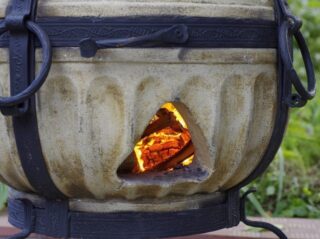A brazier or a ball-shaped brazier is used by Asian peoples for cooking. Tandoor is used for heating premises, it is used for medicinal and religious purposes. A jug-like stove is an invariable attribute in the courtyards of the peoples of many southern nationalities. Those who wish can make a tandoor with their own hands, provide for a mobile or stationary option.
The design and features of the tandoor
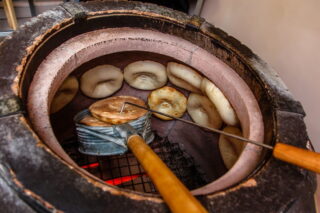
A special oven in the form of a hemisphere or a brazier with vertical sides is designed for cooking a variety of dishes. The stove has a high heat capacity, therefore it uses firewood sparingly, which is important for areas where there has always been little wood.
The special design and special characteristics of the material make the food baked rather than roasted on hot coals. The cooking process does not need to be controlled, the products are laid, then taken out ready-made. Meat cooks faster than other types of broilers.
Traditionally, they are placed in the courtyard on a support platform made of clay and concrete. The axis of the furnace can be vertical or horizontal, respectively, the mouth of the entrance is located.
Characteristics:
- the correct tandoor in the ground or on the surface is made with a volume of 0.3 - 1.4 m³;
- a round entrance is provided, which is located in the upper part or side wall, depending on the cubic capacity of the cauldron, the hole is made with a diameter of 0.0.45 - 0.75 m, the diameter of the middle area is 1.0 - 1.2 m;
- height 1.0 - 1.5 m;
- a traditional tandoor with finishing weighs 0.4 - 1.0 tons.
The walls are lined with raw bricks to increase the heat capacity. The gap between the walls of the Uzbek, Tajik tandoor and the lining is covered with slag, expanded clay.
Assortment of dishes
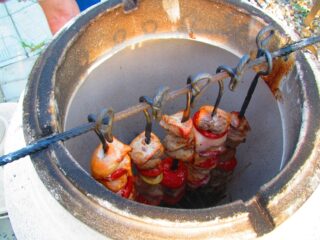
The fire is kindled inside the oven, so food can be baked regardless of the weather or season. Homemade tortilla tandoor allows you to cook baked goods, meat and vegetable dishes.
- Vertical braziers are used for baking bread, samsa, barbecue. Meat is smoked in them, the famous lamb "tandir kabob" is made.
- The horizontally installed structures are used mostly for baking cakes and tandyr-nan bread.
Uniform heating of the walls allows you not to turn the meat, you do not need to extinguish the flame. The closed structure retains the juiciness of the products without overdrying them.
Ignition and temperature conditions
The oven is heated up to operating mode within 45 - 90 minutes. The rate of temperature rise depends on the quality of the fuel, its volume, and the volume of the tandoor.
First ignition rules:
- the temperature is raised gradually, first splinters and chips are burned so as not to get a network of small cracks on the inner plane;
- do not use conifers for firewood, take acacia, oak, birch, hornbeam, beech, you can use fruit varieties.
Vegetables with a crust are baked at + 200 ° - + 220 °, for meat and samsa they heat the stove to + 200 °, fish - + 180 ° - + 195 °.
Tandoor work scheme:
Blown install on a flat surface;
- open the blower, remove the lid;
- lay and set fire to fuel;
- load food after removing soot;
- put the cover back in place, close the door.
After heating, the inner walls are wiped from black plaque, sprayed with water.The baked products are molded to the inner surface, where they are cooked through the heat. Long-handled hooks and buckets are used for excavation.
Types of tandoors
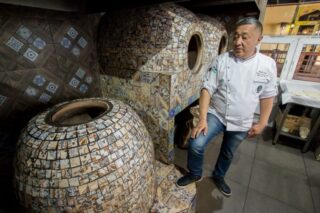
The design of a heat-resistant furnace is simple, so you can independently build a tandoor, the dimensions of which are taken as standard or the standard ones can be altered to suit your version. There are various models among individual peoples. The Uzbek and Armenian models differ.
Uzbek version of the stove is made of high-quality chamotte clay. Shredded wool of a sheep or camel is added to the composition for construction, a little sand is mixed in. The tandoor is a pommel that needs to be installed on the base of a stone hearth.
The inner insert must be made of clay, dried in the sun for 15 - 20 days. Outside, the mold is finished with white or gray clay to preserve heat. At high temperatures, animal hair burns out, as a result, the porosity provides additional thermal insulation.
Fireclay bricks are also used as lining. The combination of layers leads to the fact that heaps of brushwood are enough for heating water and baking cakes.
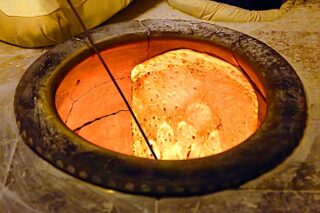
Armenian the model is distinguished by the shape of a hemisphere with a round hole in the center, sometimes the stove resembles a well in appearance. Traditionally, the tandoor was built in the ground or below the floor mark in the house. The walls of the dug hole were coated with clay mortar, then brickwork was made.
The fire was made at the bottom of the cauldron, after the temperature was set, the fuel was grouped in the center, so it gave more heat. A stove was built in Armenian villages for several families. The women bent low to attach the cakes, and they wore long mittens on their hands.
The Armenian models are distinguished by a lower temperature compared to the Uzbek ones due to their simple shape. The loss of heat does not affect the taste of the food, it only increases the cooking time.
By installation type
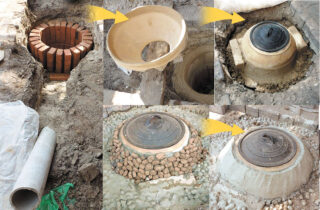
There are tandoors mounted in the ground, installed on the surface of the site, there are also special portable models.
The earthen type is placed below the level of the ground surface, they also include models that are installed inside the house. To do this, dismantle the floor, prepare a kind of recess.
Standard construction option:
- the pit is lined with ceramic heat-resistant bricks;
- laying a pad of warm camel or sheep skin, sometimes coarse sand is used for this;
- the inner layer is made with clay.
The domestic owners of summer cottages liked the simple stove, therefore it is successfully used everywhere. Food is prepared quickly, you can prepare meals for the largest company. An earthen hearth is made with a diameter of 0.8 m, a depth of -0.4 m. Placed so that there are no flammable objects nearby.
The stationary ground hearth can be folded up on a stable and secure platform. The cubic capacity of a hemispherical structure reaches 1 m³. At the bottom, they arrange a blower area with a door for air intake, and a grate is installed at the mouth of the cauldron. The entire structure is lined with stone or brick on top. The stones are taken porous so that they keep warm well.
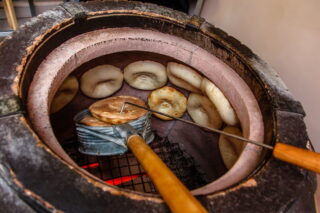
The principle of operation of a stationary installation:
- fuel is laid on ¼ of the volume;
- after 1.4 - 1.5 hours, the soot on the inner plane disappears, the surface brightens;
- in vertical devices, skewers with products are placed vertically, and cakes are attached to the walls;
- cooking takes 15 to 40 minutes.
Mobile portable models are made of kaolin clay, the shell thickness is 4 - 7 cm. Tandoors resemble barrels with side handles for rearrangement. The stoves are tightened with metal hoops to increase reliability, so the installation will stand longer.
Additional elements of the adjustable tandoor:
- nets, grates, heat-resistant baking sheets;
- nozzles for carcasses of birds and rabbits, hooks, grips;
- skewers and stands for the simultaneous preparation of different products.
Removable stoves are stored in dry conditions, since the clay loses its properties when moistened, and wet walls will crack in the cold. There are special models for restaurants and cafes.
By type of fuel
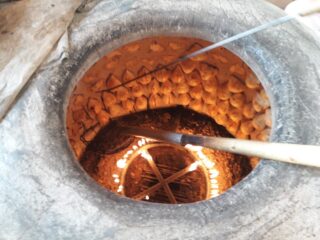
Electric and gas braziers are used in public places. These types of energy are readily available and are always available in restaurants and cafes. At home, energy-efficient options are also installed, while providing effective ventilation. The disadvantages of gas and electric braziers include the absence of haze, which gives the dishes a piquant taste. Many people use wood-fired tandoors in the old fashioned way.
Gas varieties are presented on the market with metal bodies, where a pot of chamotte or baked white clay is placed. The gaps are sealed with insulators so that the heat does not go outside. Manufacturers introduce combustible fibers inside the solution, in place of which voids are obtained to increase porosity.
The advantages of gas appliances:
- inexpensive and easy to use;
- purity of the heating process, there is no ash, waste from fuel combustion;
- with good ventilation, there are no harmful impurities in the ambient air.
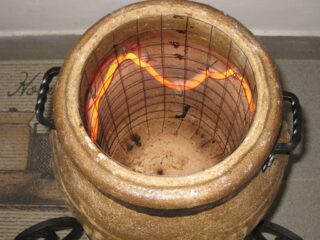
Electric panties look like a stove in a kitchen with an oven. There is a heating element under the bottom of the stove that heats the internal air. The problem with the electric tandoor is that the hot electric element dries up the air, so fish and meat delicacies are obtained without juiciness and pleasant smell.
Positive aspects of electric tandyrs:
- the possibility of using in an apartment and a house;
- beautiful gift design technique.
Wood and coal structures are more suitable for the category of classic tandoors. Modern models are represented by clay shells with thick walls. Covers and side surfaces are decorated with oriental ornaments. At the bottom there is a hatch for fuel storage.
Home appliances are installed permanently using a special technology or ready-made movable products are purchased. In the kit you can buy grills for fish, meat, bread molds, stainless steel shelves, shovels, skewer holders. The fuel is wood, charcoal, special briquettes. Pine and spruce emit resinous substances, so such firewood is not suitable.
Making from a barrel
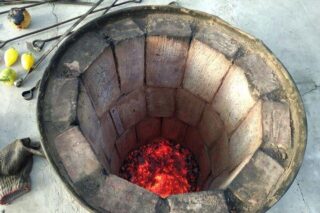
The barrel is used as a template, which is coated with chamotte clay on the outside, and brickwork is made inside.
Step-by-step instructions for preparing a barrel:
- water is poured into a container of 200 liters, left to get wet, the tree will swell after 3 - 4 days;
- the liquid is poured, dried during the day;
- soak in oil, loosen the hoops or remove them altogether.
Prepare the base for mounting the barrel. It can be made from durable concrete, brick. Correctly knead the clay solution for coating. Neglect of technology leads to cracking of the clay walls.
DIY clay model
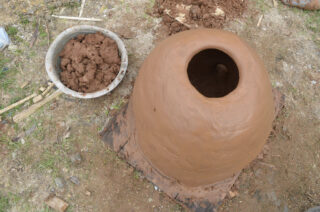
Take clay with good viscosity and plasticity. Before mixing the solution, it is poured with water for 2 - 3 days. After that, knead all the lumps, filter the mixture through a sieve. Leave for proofing to drain the emerging liquid from the surface.
Manufacturing takes place using tape technology:
- roll up strips of clay 25 cm wide, 2 cm thick, about two meters long;
- work in the shade so that the material does not dry out quickly;
- the bowl is formed from stripes in the sun, a barrel-shaped template is used, the bottom is not made;
- the diameter is narrowed at the top to make the base of the throat.
The walls are strengthened with clay, the throat of the tandoor is placed on top. The structure is mounted on a concrete base in the form of a slab.
Yamny tandoor
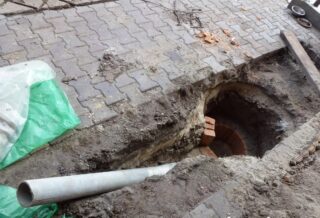
The model can be made in the form of a hemisphere or in the form of a jug. An excavation is made in the ground, and combustion air is supplied from the side. First, a brick is laid, trying to fill the entire area of the walls. The inner blank can be molded separately using a template.After the mortar dries, thermal insulation is arranged in the masonry, sand is often used.
A liner is placed inside on a clay solution, providing stability. Check operation by gradually increasing the volume of fuel.

